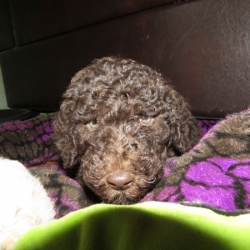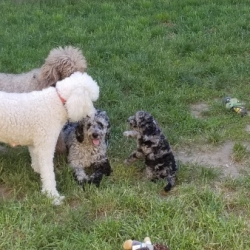


Two of the most frustrating but common parasites your puppy might be hosting are Giardia and Coccidia . These are not worms, but two species of protozoa– single-celled organismsthat reproduce in the intestines of infected animals and shed their spores into the environment through the infected animals’ feces, also feces in water sources like, rain puddles, grass and soil.
Coccidia and Giardia are both fairly common in young puppies with under developed immune systems, as well as the immune-compromised adult dog or elderly dogs.
The majority of healthy adult dogs with strong immune systems are able to fight off both giardia and coccidia before it can multiply enough to cause symptoms and is why even when they have show up with a positive fecal test will still show very mild to no symptoms at all of the disease.
This is why we recommend Nuvet Plus to our puppy families! Young puppies are not only more at risk for coccidia and giardia but they’re also at risk for having adverse reactions to the numerous vaccines they’re given the first 4 months of their life. A puppy with a strong immune system is more capable of fighting off some of these issues altogether and at the very least they are less likely to develop some of the more severe symptoms. Nuvet Plus is more then mere Vitamins it’s also an important immune system builder! It provides everything that’s lacking in their dog food. Nuvet Plus provides essential vitamins, minerals, amino acids, probioticsand enzymes crucial for early puppy development and overall good health for the life of your dogs.
Giardia in dogs does not always cause problems, but when it does it is highly unpleasant. Giardiasis is the term for the disease caused by the infection, and, as in humans, the most common symptom is diarrhea.
The parasites inhibits your dog’s ability to properly absorb nutrients, water, and electrolytes, which leads to diarrhea and weight loss. The diarrhea can be intermittent or continual, especially in puppies, and failure to diagnose and treat the disease in very young puppies can lead to severe weight loss and even death in extreme cases usually only with very young puppies under 6 wks.
Giardia is particularly common and can be dangerous for very young puppies with developing immune systems, senior dogs, and dogs with compromised immune systems. The majority of healthy adult dogswill show zero symptoms of the disease and can fight off the parasite before it Multiples enough to cause .
If a dog or puppy gets diarrhea as a result of parasites, the most common causes are Coccidia, Giardia or both.
Dogs pick up the protozoa through ingesting contaminated feces (either by eating feces, or stepping or laying in it and later licking their feet or fur); ingesting an infected animal, such as a rodent; or eating or drinking from a contaminated water source like rain puddles or eating wet grass. Birds can also pick up infected feces and spread it to far-reaching areas.
Both Giardia and Coccidia can cause moderate to severe explosive diarrhea, but each requires a different medication to treat it. There’s only slight differences in regards to the symptoms which can make it difficult to determine which one it is.
The most reliable way to diagnose Giardia and Coccidiosis is by examining a fecal sample under the microscope and it’s recommend that at least 3 seperate tests are done on different days to actually verify – so a majority of vets will just do one test and then if they don’t find anything.. will treat for one or both based on the symptoms alone and then if the treatment(s) don’t work they’ll follow up with more tests.
Both are also very contagious. Coccidia is more dangerous to puppiesand important to note that this is usually an infection of the very young puppies or elderly dogs (i.e. the immature or compromised immune system tends to let the coccidia infections reach large enough numbers to cause symptoms whereas the mature or healthy immune system probably will not.)
READ WHY WE RECOMMEND NUVET VITAMINS FOR OUR DOGS AND PUPPIES IMMUNE SYSTEMS!
Giardia is also a protozoan parasite also much more common in young puppies with immature immune systems. Adult dogs very rarely show symptoms even when infected. Giardia is picked up through ingesting contaminated water, soil, or feces.
It has a sucker on its belly which helps it to stay adhered to the inside walls of the intestines. The sucker is also what makes it Giardia one of the most stubborn parasites to treat.
What you see with your eyes:mostly in young puppies you will see moderate to severe diarrhea, stools will look normal unless the infection is more severe then you may see mucus or blood in their feces or in severe cases you may see watery, explosive diarrhea.
 Giardia is an intestinal infection that is caused by the protozoan parasite giardiasis, which is the most common intestinal parasite that is found in humans and dogs.
Giardia is an intestinal infection that is caused by the protozoan parasite giardiasis, which is the most common intestinal parasite that is found in humans and dogs.Blood tests appear normal with the possible exception of an increase in a type of white blood cells and mild anemia.
If it were me I would start by deworming your dogs (all your dogs) with Panacur or Safeguarddewormer for a 3 day course (info below). At this time nothing else works as well for Giardia, and Metronidazole and Flagyl only stops it for a short time, then it returns.
Safe Guard (Fenbendazole Suspension) – Puppy and Dog Dosage Chart: https://www.dreamydoodles.com/fenbendazole
For the treatment and control of Roundworms (Toxocara canis Toxascaris leonina) Hookworms (Ancylostoma caninum Uncinaria stenocephala) Whipworms (Trichuris vulpis) and Tapeworms (Taenia pisiformis) and Giardia.
Safe-Guard ® (Fenbendazole) Canine is safe for use in puppies 6 weeks or older and adult dogs including pregnant bitches.
WARNING: BEFORE YOU WORM WITH PANACUR OR SAFE-GUARD FOR DOGS MAKE SURE YOUR DOG HAS BEEN TESTED FOR HEARTWORM AND ON A HEARTWORM MEDICINE DAILY. IF NOT, AND YOUR DOG HAS ADULT HEART WORMS, IT WILL KILL THE HEARTWORMS BUT THE DEAD WORMS CLOG THE HEART AND IT WILL KILL YOUR DOG. MAKE SURE YOU ARE WORKING WITH YOUR VET ON THIS SO THERE IS NO MISTAKE WHEN USING DRUGS.
Coccidia are small protozoans (one-celled organisms) that live in the intestinal tracts of dogs and cats. They cause disease most commonly in puppies and kittens less than six months of age, in adult animals whose immune system is suppressed, or in animals who are stressed in other ways (e.g.; change in ownership, other disease present).In dogs and cats, most coccidia are of the genus called Isospora . Isospora canis and I. ohioensis are the species most often encountered in dogs. Regardless of which species is present, we generally refer to the disease as coccidiosis. As a puppy ages, he tends to develop a natural immunity to the effects of coccidia. As an adult, he may carry coccidia in his intestines, and shed the cyst in the feces, but experience no ill effects. All dogs have some level of Coccidia in their gut. When a dog is stressed (i.e. being shipped, moving into a new environment etc ) the stress can cause the Coccidia to bloom and flair up causing diarrhea. The solution is to give the dog ALBON. How much and how it is administered is a question for your vet.
A puppy is not born with the coccidia organisms in his intestine. However, once born, the puppy is frequently exposed to his mother’s feces, and if the mother is shedding the infective cysts in her feces, then the young animals will likely ingest them and coccidia will develop within the young animal’s intestines. Since young puppies, usually those less than six months of age, have no immunity to coccidia, the organisms reproduce in great numbers and parasitize the young animal’s intestines. Oftentimes, this has severe effects. From exposure to the coccidia in feces to the onset of the illness is about 13 days. Most puppies who are ill from coccidia are, therefore, two weeks of age and older. Although most infections are the result of spread from the mother, this is not always the case. Any infected puppy or kitten is contagious to other puppies or kittens. In breeding facilities, shelters, animal hospitals, etc., it is wise to isolate those infected from those that are not.
The primary sign of an animal suffering with coccidiosis is diarrhea. The diarrhea may be mild to severe depending on the level of infection. Blood and mucous may be present, especially in advanced cases. Severely affected animals may also vomit, lose their appetite, become dehydrated, and in some instances, die from the disease. Most infected puppies encountered by the authors are in the four to twelve week age group. The possibility of coccidiosis should always be considered when a loose stool or diarrhea is encountered in this age group.
A microscopic fecal exam by a veterinarian will detect the cysts confirming a diagnosis. It should be mentioned that stress plays a role in the development of coccidiosis. It is not uncommon for a seemingly healthy puppy to arrive at his new home and develop diarrhea several days later leading to a diagnosis of coccidia.
If the puppy has been at the new home for less than thirteen days, then he had coccidia before he arrived. Remember, the incubation period (from exposure to illness) is about thirteen days. If the puppy has been with his new owner several weeks, then the exposure to coccidia most likely occurred after the animal arrived at the new home.
Although many cases are mild, it is not uncommon to see severe, bloody diarrhea result in dehydration and even death. This is most common in animals who are ill or infected with other parasites, bacteria, or viruses. Coccidiosis is very contagious, especially among young puppies. Entire kennels may become contaminated, with puppies of many age groups simultaneously affected.
Fortunately, coccidiosis is treatable. Drugs such as sulfadimethoxine (Albon ® ) and trimethoprim-sulfadiazine (Tribrissen ® ) have been effective in the treatment and prevention of coccidia. Because these drugs do not kill the organisms, but rather inhibit their reproduction capabilities, elimination of coccidia from the intestine is not rapid.
By stopping the ability of the protozoa to reproduce, time is allowed for the puppy’s own immunity to develop and remove the organisms. Drug treatments of one to three weeks are usually required.
Because coccidia is spread by the feces of carrier animals, it is very important to practice strict sanitation. All fecal material should be removed. Housing needs to be such that food and water cannot become contaminated with feces.
Clean water should be provided at all times. Most disinfectants do not work well against coccidia; incineration of the feces, and steam cleaning, immersion in boiling water, or a 10% ammonia solution are the best methods to kill coccidia. Coccidia can withstand freezing.
Cockroaches and flies can mechanically carry coccidia from one place to another. Mice and other animals can ingest the coccidia and when killed and eaten by a dog, for instance, can infect the dog. Therefore, insect and rodent control is very important in preventing coccidiosis.
While there are species of coccidia that can infect people ( Toxoplasma and Cryptosporidium , for example), the Isospora species of dogs and cats are not infective to people.
Breeders need to keep those nasty parasites in check and the best way to do it is to have a good and consistent deworming protocal for not only your puppies but your whole pack of dogs whether they’re pregnant or not if they are on your property you need to deworm everyone at the same times.
Puppies need to be dewormed at 2,4,6,8 Weeks or every 2 wks until they go home up until 16 weeks and then every 6 months once they go home.
I use Pyrantel Pamoate first won our Puppies at 2 and 4 wks (1 day dosage) and then Safeguard starting at 6 weeks. Once a day for 3 days. (and again every 2 weeks).
Puppies must be 6 wks or older to use the Safeguard, that’s why I use the Pyrantel Pamoate for the first 4 weeks.
*Remember to deworm your whole pack with Safeguard 2 weeks before whelping a litter and everytime you deworm the puppies except I only use the Safeguard on my adults not the Pyrantel because Safeguard covers more types of worms and also treats Giardia .
*Remember Adult Dogs can have Giardia and/or Coccidia and pass it onto the puppies while still showing no symptoms themselves. Most adult dogs are immune to giardia by adulthood but it gives young puppies moderate to severe diarrhea and can even kill them if left untreated or they are really young. Giardia and Coccidia have very similiar symptoms so you may need to get a fecal test done to diagnose the exact issue.
I recommend buying the big bottle if you plan on having a few litters a year or have more then 4-5 dogs.
Deworming Puppies – Safeguard (Fenbendazole)
I use the Safeguard Bottle labeled for Goats and Cows. Starting at (6wks+) Same medication. Different dosage chart. You get more of the medication for your money.
Puppy and Dog Dosage Chart: https://www.dreamydoodles.com/fenbendazole
Buy Safegaurd for Goats on Amazon

Pyrantel Pamoate Suspension 50 mg 16 oz
![]()
Deworming Puppies & Dogs – Pyrantel Pamoate Dosage Chart (2wks & 4wks):
I use the Pyrantel Pamoate 50 mg to 1 ml Suspension bottle by Columbia Factories (last longer; different dosage chart then Nemex 2).
* Buy the Pyrantel Pamoate 50 mg to 1ml Bottle by Columbia Factories (labeled for humans) on Amazon
Same exact medication just a different dosage chart. You get WAY more for your money.
*For proper dosing use a 1cc -1ml oral dosing syringe for puppies and a 3 or 5 ML oral dosing syringe for Adults.
You can also use Nemex 2 (PYRANTEL PAMOATE) instead of the Columbia Factories brand above but it is a different dosage and you will need to spend alot more money in order to deworm everyone in your litter especially if you have multiple litters.
The dosage instructions are on the bottle. Nemex 2 (PYRANTEL PAMOATE) does NOT TREAT GIARDIA OR COCCIDIA.
Liquid wormer removes large roundworms and hookworms in dogs and puppies.
Tags: coccidia , dog breeders , dog breeding , FAQ , giardia , health , Sickness , Whelping , whelping supplies
We have a Private Group on Facebook that's just for our Dreamydoodle Puppy Families
!
Plz Click Below to Join Us.. Please don't forget to answer the questions on the join request screen so our Admins know to accept your request!

